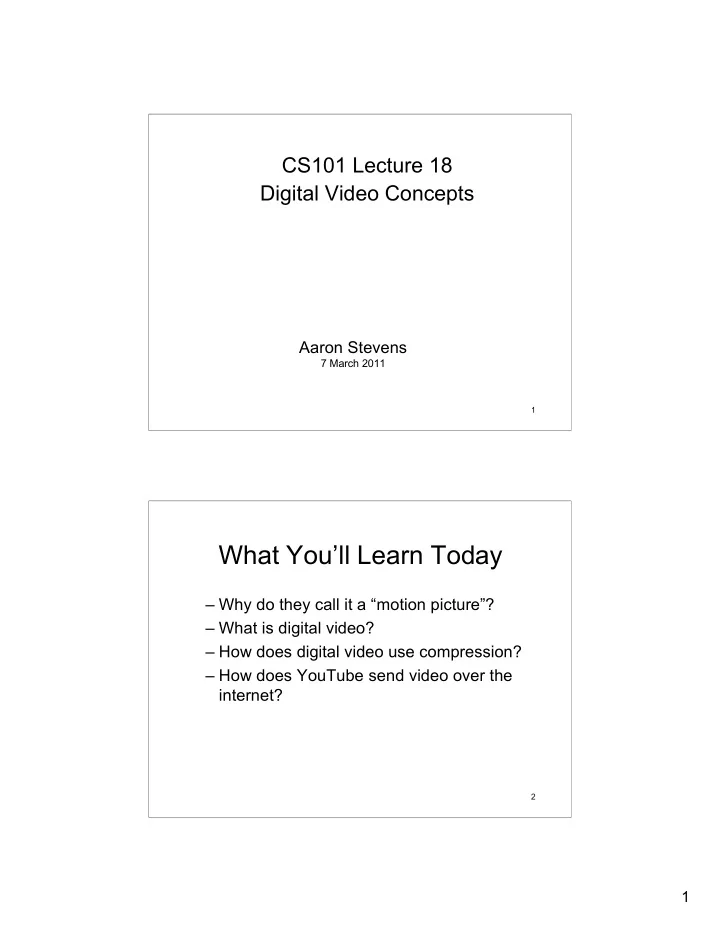

CS101 Lecture 18 Digital Video Concepts Aaron Stevens 7 March 2011 1 What You’ll Learn Today – Why do they call it a “motion picture”? – What is digital video? – How does digital video use compression? – How does YouTube send video over the internet? 2 1
Who invented moving pictures? "I am experimenting upon an instrument which does for the eye what the phonograph does for the ear, which is the recording and reproduction of things in motion ...." Thomas A. Edison 1888 3 Moving Pictures How do you make moving pictures out of still images? – Play enough images quickly enough to fool the mind into perceiving the images as continuous. – Analogous to sampling by taking many successive pictures. 4 2
Example: Flip Book 5 5 Frame Rate The frame rate describes how many distinct images per second. Below which frame rate do humans see discrete picture versus animation? Show: frame rate examples – Television plays out at 30 frames/sec. – 35 mm movie cameras use a standard of 24 frames/second. 6 3
TV Data Requirements Consider: – 480 * 360 pixels (standard TV resolution) – 3 bytes per pixel (TrueColor) = 518,400 bytes per frame – 30 frames/second = 15,552,000 bytes per second How much data per minute? What about the audio? 7 Data Requirements CD Audio Requirements: – 16 bits per channel – 44,100 samples/sec = 1,411,200 bits/sec = 176,400 bytes/sec “TV + CD Audio” data requirements: 15,728,400 bytes per second – This works out to about 14 megabytes per second of data – A standard CD ROM holds about 700 MB, almost enough for 50 seconds of video + audio 8 4
But That’s Ridiculous! Of course, the data requirements on the previous slides are ridiculous! Why? 9 Compressing Video Video compression is key to getting enough video onto a physical medium (e.g. DVD). Video codec -- COmpressor/DECompressor Algorithms used to shrink the size of a movie to allow it to be played on a computer or over a network. Most codecs use lossy compression -- why? 10 5
Video Compression Video is effectively a 3-dimensional array of pixels: – Two spatial dimensions (width & height) – One time dimension (across frames) Video data contains spatial and temporal redundancy. 11 Spatial Compression Based on removing redundant information within a frame. – effectively what the JPEG format does. – JPEG can typically achieve 90% or 95% reduction in file image size without a visible loss in quality. 12 6
Temporal Compression Based on differences between consecutive frames. Example: 13 Digital Video Formats • MPEG-2 (standard definition DVD) – compresses video 15-30 times • Quicktime – Incorporates Apple and open standard protocols for audio, images, video codecs • MPEG-4 – Enables streaming over networks, iPhone • Flash Video Player – Installed in about 99% of web browsers 14 7
Flash Video Flash applications can run in enabled browsers – Flash Video Player runs as an application (.SWF file) – .FLV files are embedded or linked to from SWF. – Content can be delivered as progressive 15 download. Flash Video Streaming Video – Uses Flash Media Server – Example: CNN Live Progressive Download – Uses standard web server – Example: YouTube videos 16 8
Aspect Ratio Aspect ratio describes the width:height: (left) SD TV 4:3 (n/s) European Flat 5:3 (right) HD TV 16:9 17 How does YouTube do it? – Video player built on Macromedia’s Flash v.7 – Standard video playback in 320 by 240 pixels at 25 frames per second • Average bitrate is about 200kbps for video – Audio: an embedded MP3 audio stream, one channel • Average bitrate is 64kbps (or 22050 Hz). 18 9
Many Flavors of YouTube 19 YouTube: YMMV 20 10
Video Chat/Conferencing Apple’s iChat video chat provides up to: – 640 by 480 resolution (320 by 240) – 20 frames/second Data requirements are 900 kbps – on a LAN segment it will use up to 2000 kpbs. Why such high bitrates? (YouTube video + audio is 25 fps in ~264kbps) 21 What You Learned Today – Moving pictures – Codec – Temporal and spatial compression – Flash video – YouTube, Video Chat 22 11
Announcements and To Do List – HW 7: Digital Audio due WED 3/9 – Readings: • Wong ch 6 pp 158-188 (today) • General about Flash (Wednesday): http://www.mediacollege.com/adobe/flash/ • Flash tutorial: http://www.w3schools.com/Flash/default.asp – You might want to download the 30-day trial version of Flash CS5: http://www.adobe.com/go/tryflash 23 12
Recommend
More recommend